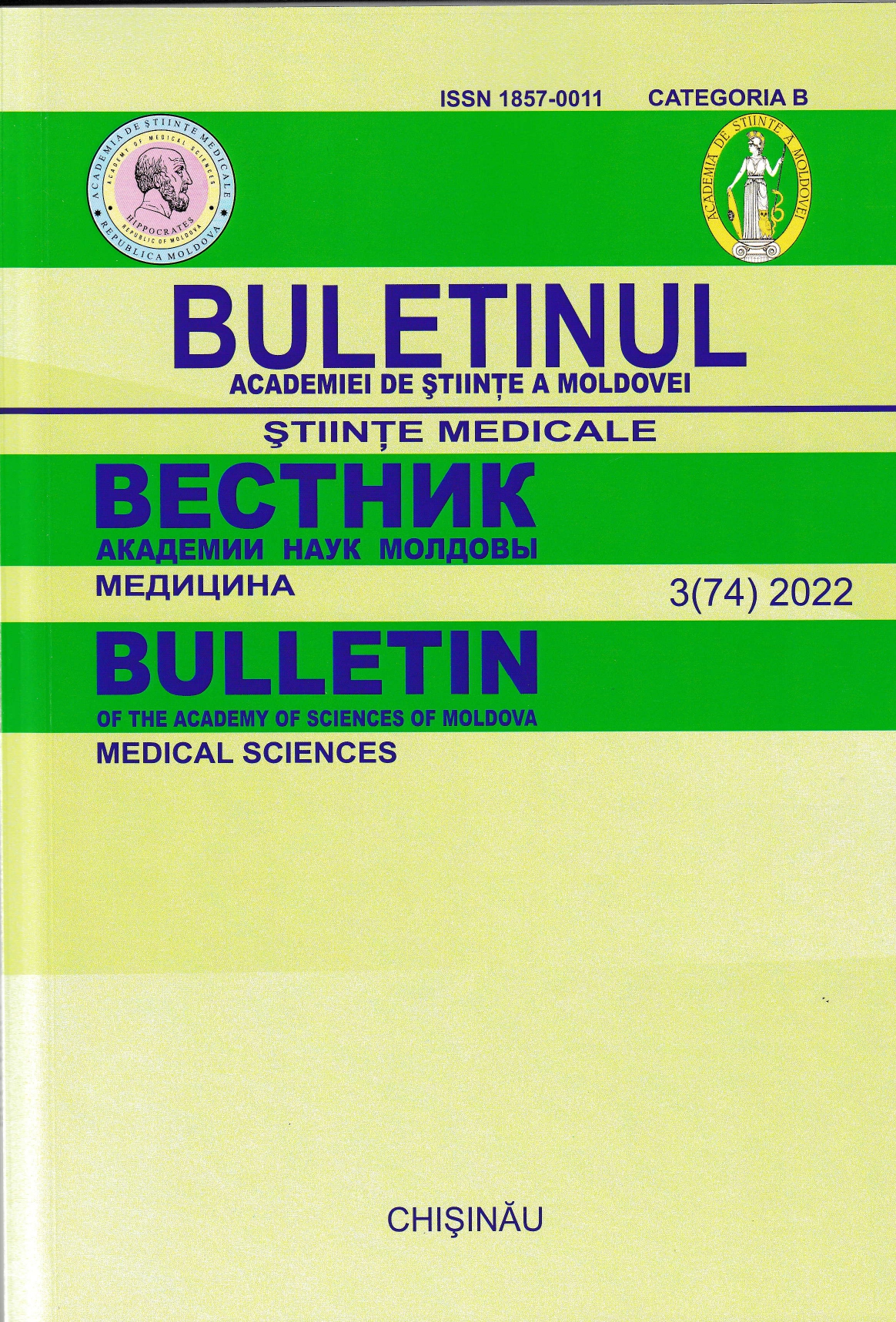TULBURĂRILE DE RITM CIRCADIAN ȘI NEURODEGENERAREA PRIN PRISMA BOLII PARKINSON ȘI A TULBURĂRILOR COGNITIVE
DOI:
https://doi.org/10.52692/1857-0011.2022.3-74.01Cuvinte cheie:
tulburările de ritm circadian, boala Parkinson, tulburări cognitive, boli neurodegenerative, demența, ceasul circadian, genele CLOCKRezumat
Tulburările de ritm circadian (TRC) se atribuie stilului de viață modern caracterizat prin expunere îndelungată la surse de lumină albastră, lucru în ture, stres cronic și viață socială nocturnă. În mod individual, ritmurile circadiene dezorgani- zate constituie factori de risc în dezvoltarea diferitor patologii, printre care și cele neurodegenerative. În paralel, observăm îmbătrânirea populației cu creșterea incidenței bolilor neurodegenerative (BN), declinul cognitiv devenind o problemă societală. Astfel, această sinteză a literaturii își propune conturarea interconexiunii TRC - BN - tulburări cognitive din aspect fiziopatologic în baza modelului bolii Parkinson. Obiectivul final al studiului este evidențierea metodelor de profi- laxie a declinului rezervei cerebrale și cognitive produse de TRC în scopul ameliorării calității vieții prin scăderea anilor de viață ajustați cu incapacitate (DALY).
Referințe
Leng Y, Musiek ES, Hu K, Cappuccio FP, Yaffe K. Association between circadian rhythms and neurodegenerative diseases. Lancet Neurol. 2019;18(3):307-318. doi:10.1016/S1474-4422(18)30461-7
Lananna B V., Musiek ES. The wrinkling of time: Aging, inflammation, oxidative stress, and the circadian clock in neurodegeneration. Neurobiol Dis. 2020;139(March). doi:10.1016/j.nbd.2020.104832
Berry RB, Wagner MH. Circadian Rhythm SleepWake Disorders. Sleep Medicine Pearls. Published online 2015:626-634. doi:10.1016/b978-1-4557-7051-9.00040-1
Steele TA, St Louis EK, Videnovic A, Auger RR. Circadian Rhythm Sleep–Wake Disorders: a Contemporary Review of Neurobiology, Treatment, and Dysregulation in Neurodegenerative Disease. Neurotherapeutics. 2021;18(1):53-74. doi:10.1007/s13311-021-01031-8
Hou Y, Liu L, Chen X, Li Q, Li J. Association between circadian disruption and diseases: A narrative review. Life Sci. 2020;262. doi:10.1016/j.lfs.2020.118512
Carter B, Justin HS, Gulick D, Gamsby JJ. The Molecular Clock and Neurodegenerative Disease: A Stressful Time. Front Mol Biosci. 2021;8(March):1-18. doi:10.3389/fmolb.2021.644747
Vallée A, Lecarpentier Y, Guillevin R, Vallée JN. Circadian rhythms, Neuroinflammation and Oxidative Stress in the Story of Parkinson’s Disease. Cells. 2020; 9(2):1-15. doi:10.3390/cells9020314
Kinoshita C, Aoyama K, Nakaki T. Neuroprotection Afforded by Circadian Regulation of Intracellular Glutathione Levels: A Key Role for MiRNAs. Vol 119. Elsevier B.V.; 2018. doi:10.1016/j.freeradbiomed.2017.11.023
Valdez P. Circadian Rhythms in Attention. Vol 92.; 2019.
Gonzalez MMC, Desseilles M, Peirson SN, et al. Light and Cognition: Roles for Circadian Rhythms, Sleep, and Arousal. Front Neuroendocrinol. 2018;9:1. doi:10.3389/fneur.2018.00056
Wu H, Dunnett S, Ho YS, Chang RCC. The role of sleep deprivation and circadian rhythm disruption as risk factors of Alzheimer’s disease. Front Neuroendocrinol. 2019;54:100764. doi:10.1016/j.yfrne.2019.100764
Cardinali DP. Melatonin and Healthy Aging. Vol 115. 1st ed. Elsevier Inc.; 2021. doi:10.1016/bs.vh.2020.12.004
Stern Y, Arenaza-Urquijo EM, Bartrés-Faz D, et al. Whitepaper: Defining and investigating cognitive reserve, brain reserve, and brain maintenance. Alzheimer’s and Dementia. 2020; 16(9):1305-1311. doi:10.1016/j.jalz.2018.07.219
Goldstein CA. Overview of circadian sleep-wake rhythm disorders. UpToDate. Published online 2022:1-33.
Wilckens KA, Chahine LM. Sleep and circadian rhythms in the treatment, trajectory, and prevention of neurodegenerative disease. Neurobiol Dis. 2020; 145(September). doi:10.1016/j.nbd.2020.105075
Madore C, Yin Z, Leibowitz J, Butovsky O. Microglia, Lifestyle Stress, and Neurodegeneration. Immunity. 2020; 52(2):222-240. doi:10.1016/j.immuni.2019.12.003
Kovacs GG. Concepts and Classification of Neurodegenerative Diseases. Vol 145. 1st ed. Elsevier B.V.; 2018. doi:10.1016/B978-0-12-802395-2.00021-3
Chen D, Zhang T, Lee TH. Cellular mechanisms of melatonin: Insight from neurodegenerative diseases. Biomolecules. 2020;10(8):1-26. doi:10.3390/biom10081158
Deuschl G, Beghi E, Fazekas F, et al. The burden of neurological diseases in Europe: an analysis for the Global Burden of Disease Study 2017. Lancet Public Health. 2020; 5(10):e551-e567. doi:10.1016/S2468-2667(20)30190-0
Mendoza-Velásquez JJ, Flores-Vázquez JF, Barrón-Velázquez E, Sosa-Ortiz AL, Illigens BM, Siepmann T. Autonomic Dysfunction in α-Synucleinopathies. Autonomic Dysfunction in α-Synucleinopathies Front Neurol. 2019; 10:363. doi:10.3389/fneur.2019.00363
Nelson PT, Dickson DW, Trojanowski JQ, et al. Limbic-predominant age-related TDP-43 encephalopathy (LATE): Consensus working group report. Brain. 2019;142(6):1503-1527. doi:10.1093/brain/awz099
Caproni S, Colosimo C. Diagnosis and Differential Diagnosis of Parkinson Disease. Clin Geriatr Med. 2020;36(1):13-24. doi:10.1016/j.cger.2019.09.014
De Lazzari F, Bisaglia M, Zordan MA, Sandrelli F. Circadian rhythm abnormalities in parkinson’s disease from humans to flies and back. Int J Mol Sci. 2018;19(12):1-22. doi:10.3390/ijms19123911
van Heesbeen HJ, Smidt MP. Entanglement of Genetics and Epigenetics in Parkinson’s Disease. Front Neurosci. 2019;13(March):1-15. doi:10.3389/fnins.2019.00277
Wu H, Dunnett S, Ho YS, Chang RCC. The role of sleep deprivation and circadian rhythm disruption as risk factors of Alzheimer’s disease. Front Neuroendocrinol. 2019;54(January):100764. doi:10.1016/j.yfrne.2019.100764
Nedergaard M, Goldman SA. Glymphatic failure as a final common pathway to dementia. Science (1979). 2020; 56(October):50-56.
Svensson E, Horváth-Puhó E, Thomsen RW, et al. Vagotomy and subsequent risk of Parkinson’s disease. Ann Neurol. 2015; 78(4):522-529. doi:10.1002/ana.24448
Descărcări
Publicat
Număr
Secțiune
##category.category##
Licență
Copyright (c) 2022 Buletinul Academiei de Științe a Moldovei. Științe medicale

Această lucrare este licențiată în temeiul Creative Commons Attribution 4.0 International License.



